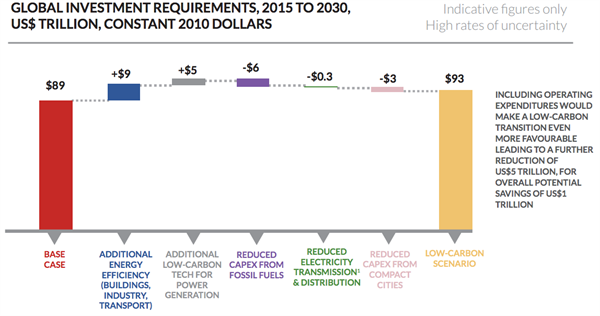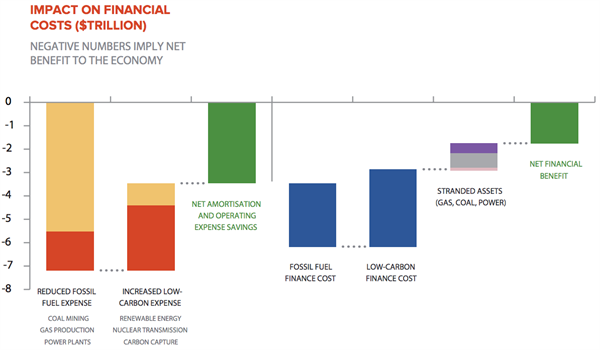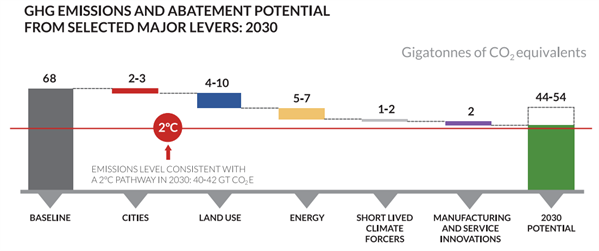The world is going to have to spend trillions investing in new transport, buildings and energy systems. So why not spend a little more to get all the long-term benefits of a cleaner, greener economy? That’s the questions posed by a group of senior politicians, economists and business leaders today.
The Global Commission on the Economy and Climate’s new report says the world is set to spend $89 trillion over the next 15 years upgrading the infrastructure underpinning the global economy. It says it would cost just $270 billion more each year- an extra five per cent – to do this in a climate friendly way.
Once the economic benefits of having cleaner air, more energy efficient buildings and reduced fossil fuel dependency are taken into account, these upgrades are effectively free, it says. And that’s before the economic benefit of avoiding climate change is factored in.
Here’s three graphs showing why the report says investing in a low carbon future is good for the global economy.
Economic shifts
The global economy is set to undergo some profound economic shifts in the next 15 years, the report says. The additional cost of making that growth low carbon? A “relatively modest” $4 trillion, the report says.
But as this graph shows, implementing low carbon policies can save money, too:
The world is set to invest about $6 trillion a year to drive economic growth – $89 trillion over the next 15 years. A low carbon approach would add $600 billion a year for energy efficient buildings, transport systems and industry, and $330 billion to switch from fossil fuels to renewables.
But those costs are largely offset. For instance, countries could save $400 billion a year from not having to build new fossil fuel plants. More compact, efficient cities would save countries $200 billion a year by avoiding the need for sprawling transport infrastructure.
Benefits outweigh costs
This is particularly true in the energy sector, the report finds. The total cost of switching to a low carbon energy system is outweighed by the economic benefits, it says.
Switching to low carbon energy sources has a number of advantages: for instance, they don’t pollute the air and they can provide electricity for free once they’re up and running. The problem is, they cost quite a lot to build in the first place.
This graph shows the costs compared to the economic benefits of switching to low carbon electricity generation. It should be read left to right, starting with the biggest benefit:
The left half of the graph shows countries could save around $7 trillion by not having to build as many new fossil fuel power plants, and extract as much coal and gas to power them (the left bar). The cost of building enough renewables to replace these fossil fuels? Around $3.5 trillion over the next 20 years (the middle orange bar). That means counties save around $3.5 trillion overall (the middle green bar).
But building that much low carbon power will cost money, too. Investors would have to spend an additional $1.5 trillion financing the new renewables, the report estimates (the blue bars). They’d also have to write-off a little over $1 trillion worth of fossil fuel assets, as lots of coal and gas would stay in the ground as a consequence of switching to renewables (the purple, grey and pink bar).
Overall, switching from fossil fuels to low carbon power could save $1.8 trillion between 2015 and 2035 (the green bar on the right), the report says.
Cutting emissions
The report makes clear that investing in a low carbon future could have economic benefits in its own right, echoing a UK report published last week. But it would also help avoid the worst impacts of climate change.
If global emissions keep growing at current rates they will reach 68 gigatonnes of carbon dioxide in 2030, the report says. Implementing the report’s recommendations could prevent up to 24 gigatonnes of carbon dioxide being emitted, it estimates:
But that wouldn’t be quite enough to bring emissions down to a level that could limit warming to two degrees above pre-industrial levels. For that to happen, the report concedes that countries would have to implement policies with net costs.
Nonetheless, those costs “are almost certainly outweighed by the future economic damages associated with warming of more than [two degrees] that they would avoid”, it says.
The commission’s report shows a range of climate-friendly policies can be economically beneficial. Once the benefit of avoiding future damages associated with climate change is added in, it would seem to make sense to spend a bit driving low carbon development today.




